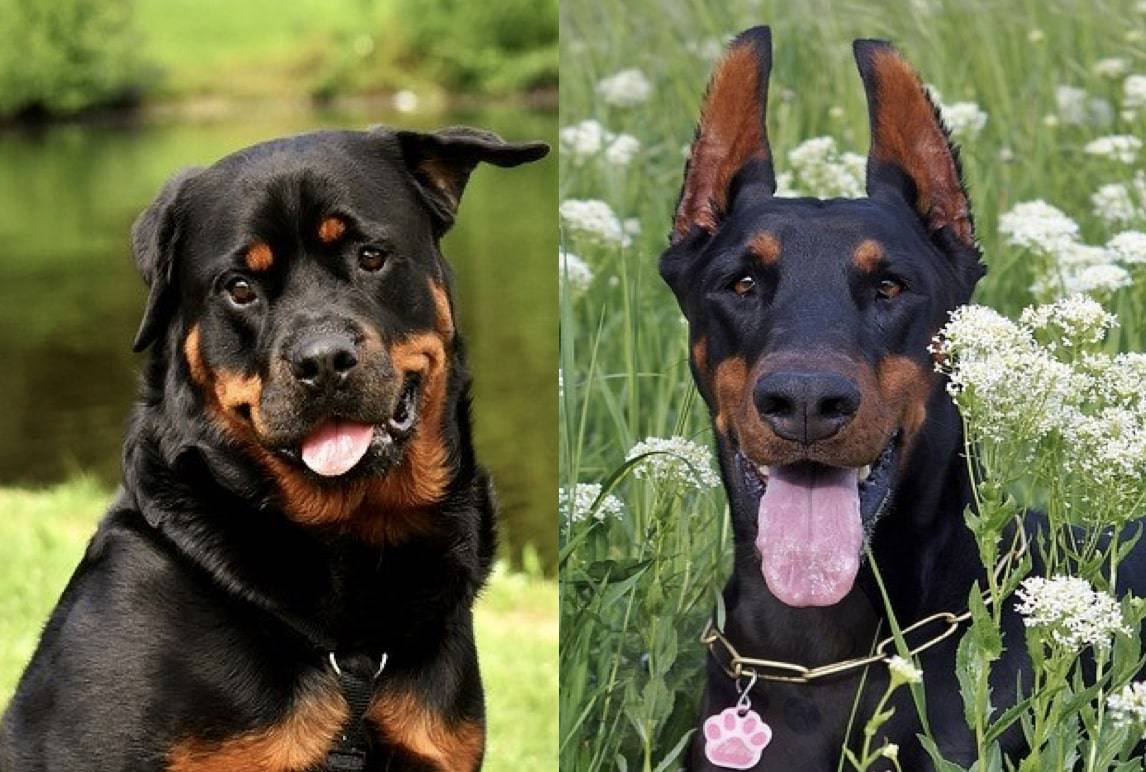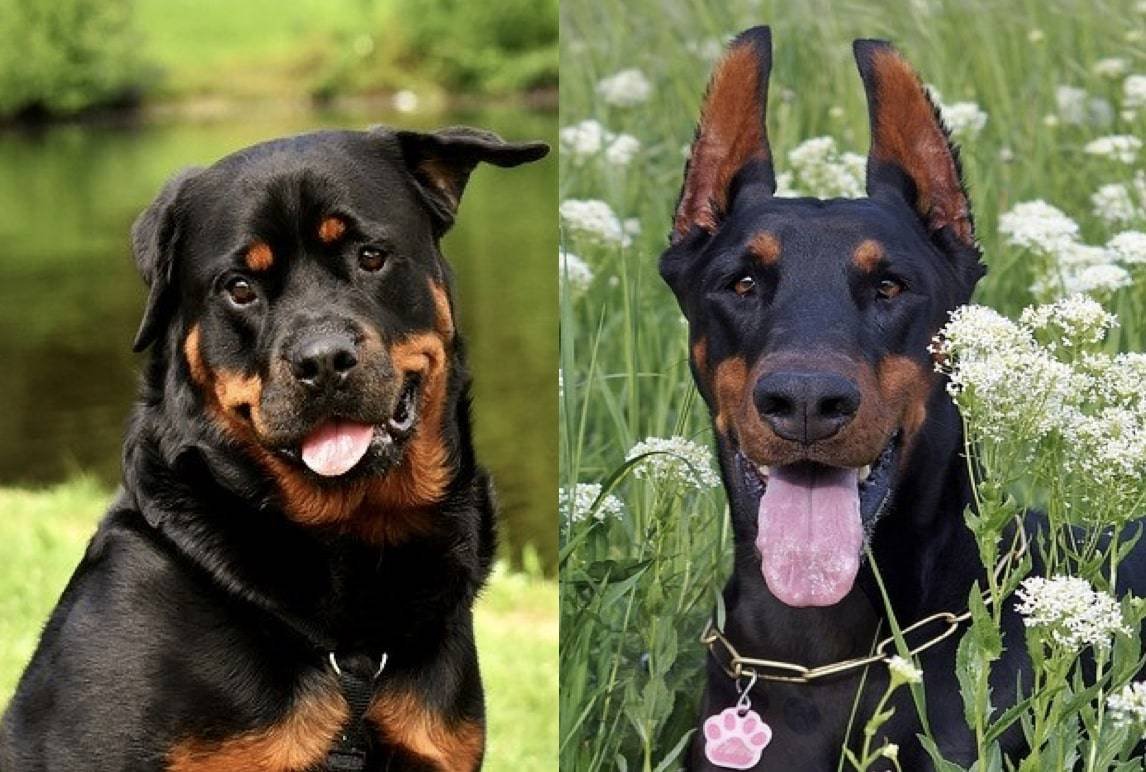When it comes to loyal and protective canine companions, the Doberman and Rottweiler are two breeds that often come to mind. With their imposing presence and powerful build, these dogs have earned a reputation for being excellent guard dogs. But did you know that despite their fierce appearance, both the Doberman and Rottweiler can also be incredibly gentle and affectionate towards their families? It’s true! These breeds have a strong instinct to protect, but they are also known for their loyalty and devotion to their human pack.
The Doberman and Rottweiler have a rich history that adds to their appeal as loyal and capable dogs. The Doberman breed was developed in the late 19th century by a German tax collector named Louis Dobermann, who wanted a reliable and protective companion for his job. The Rottweiler, on the other hand, has ancient origins and can be traced back to the Roman Empire, where they were used as working dogs. Today, both breeds are popular choices for families looking for a dependable and confident canine companion. In fact, according to the American Kennel Club, the Rottweiler ranks 8th in popularity among all dog breeds in the United States, while the Doberman is not far behind at 17th.
Dobermans and Rottweilers are both robust, intelligent, and loyal dog breeds. While both are known for their protective instincts, Dobermans are more agile and excel in tasks like obedience and agility training. On the other hand, Rottweilers are known for their strength and natural guarding abilities. They both require firm training and socialization from an early age. Both breeds make excellent family pets but require experienced owners who can provide them with proper training and socialization.

Are Dobermans and Rottweilers?
Dobermans and Rottweilers are both popular dog breeds known for their intelligence, strength, and loyalty. Many people often wonder about the similarities and differences between these two breeds. In this article, we will explore the key characteristics, temperaments, and care requirements of Dobermans and Rottweilers to better understand what sets them apart and what makes them unique.
Physical Appearance
Dobermans and Rottweilers are both large and muscular breeds, but they have distinct physical differences. Dobermans are known for their sleek and athletic build. They have short coats and come in various colors, including black, red, blue, and fawn. Rottweilers, on the other hand, have a more robust and stocky appearance. They have a thick double coat, usually black with tan markings on their face, chest, and legs.
While Dobermans and Rottweilers are both powerful dogs, Dobermans are lighter and more agile, while Rottweilers have a heavier and more substantial build. These physical differences reflect the different roles these breeds historically played as working dogs.
Temperament and Personality
Dobermans and Rottweilers have distinct temperaments, although they are both known to be protective and loyal to their families. Dobermans are often described as energetic, intelligent, and alert. They are highly trainable and excel in activities such as obedience training, agility, and even search and rescue. Rottweilers, on the other hand, are known for their calm and confident nature. They are typically more reserved and can be protective of their family and territory.
Both breeds require early socialization and proper training to ensure they grow up to be well-rounded and obedient dogs. It is important to provide them with mental stimulation and regular exercise to prevent boredom and destructive behavior.
Exercise and Training Needs
Both Dobermans and Rottweilers are active breeds that require regular exercise to maintain their physical and mental well-being. Dobermans are known for their high energy levels and need plenty of physical activity. They enjoy long walks, runs, and interactive play sessions. Rottweilers also require daily exercise but tend to have a more moderate energy level.
Training is essential for both breeds to ensure they become well-behaved and obedient companions. Dobermans, with their intelligence and eagerness to please, respond well to positive reinforcement training methods. Rottweilers, while intelligent, can be more stubborn and may require a firm and consistent training approach.
Health and Care
Dobermans and Rottweilers, like all dog breeds, are prone to certain health issues. Dobermans are susceptible to conditions such as hip dysplasia, cardiomyopathy, and von Willebrand’s disease. Regular veterinary check-ups, a balanced diet, and exercise can help maintain their overall health.
Rottweilers are also prone to hip dysplasia, as well as conditions like elbow dysplasia and aortic stenosis. Regular exercise, a nutritious diet, and preventive care can help reduce the risk of these health issues.
Grooming
When it comes to grooming, Dobermans have short coats that require minimal maintenance. They shed moderately, and regular brushing can help keep their coat in good condition. Rottweilers, with their double coat, shed more heavily, especially during seasonal changes. They may require more frequent brushing to manage the shedding.
Conclusion
Dobermans and Rottweilers are two distinct breeds with their own unique characteristics. While Dobermans are known for their athleticism, intelligence, and sleek appearance, Rottweilers are recognized for their confidence, loyalty, and robust build. Both breeds make excellent companions for experienced dog owners who are willing to invest time and effort into their training and care.
Key Takeaways:
- Doberman and Rottweiler are both popular dog breeds.
- Dobermans are known for their loyalty, intelligence, and protective nature.
- Rottweilers are strong, confident, and make excellent guard dogs.
- Both breeds require early socialization, training, and regular exercise.
- Dobermans and Rottweilers can be great family pets with proper care and training.
Frequently Asked Questions
Here are some commonly asked questions about Dobermans and Rottweilers:
1. What are the main differences between Dobermans and Rottweilers?
Dobermans and Rottweilers are both large, powerful dog breeds, but there are some key differences between them. Dobermans are known for their sleek and athletic build, while Rottweilers are bulkier and more muscular. Additionally, Dobermans have a more energetic and alert temperament, while Rottweilers are generally calmer and more laid-back.
Dobermans are often considered more suitable for active individuals or families who can provide them with plenty of exercise and mental stimulation, while Rottweilers may be a better fit for those who prefer a slightly more relaxed and easygoing companion. It’s important to note that individual personalities can still vary within each breed, so it’s essential to spend time with specific dogs before making any decisions.
2. Are Dobermans and Rottweilers good with children?
Both Dobermans and Rottweilers can be great with children when properly trained and socialized from a young age. They are generally loyal and protective, making them natural guardians for their families. However, due to their size and strength, it’s crucial to supervise interactions between dogs and young children to ensure everyone’s safety.
It’s also important to note that individual temperament can play a significant role. Some Dobermans and Rottweilers may have a higher prey drive or be more reserved around strangers, so early socialization and training are crucial to raise well-behaved and friendly dogs.
3. Are Dobermans and Rottweilers aggressive breeds?
Dobermans and Rottweilers are often labeled as “aggressive” breeds due to their protective instincts and physical capabilities. However, it’s essential to understand that aggression is not a natural or inherent characteristic of these breeds.
Proper socialization, training, and responsible ownership play a significant role in shaping a dog’s behavior. With early socialization, positive reinforcement training, and consistent guidance, Dobermans and Rottweilers can be well-behaved and friendly companions. Like any other breed, individual personality and temperament can still vary, so it’s crucial to choose a dog that fits your lifestyle and invest time and effort into their upbringing.
4. Do Dobermans and Rottweilers have any health issues?
Like many large dog breeds, Dobermans and Rottweilers are prone to certain health issues. Dobermans are more susceptible to conditions like dilated cardiomyopathy, hip dysplasia, and von Willebrand’s disease. On the other hand, Rottweilers are prone to hip dysplasia, osteosarcoma, and certain heart conditions. Regular vet check-ups, a balanced diet, and providing them with regular exercise can help mitigate these risks.
It’s always recommended to consult with a reputable breeder or veterinarian when considering getting a Doberman or Rottweiler to ensure you are aware of any breed-specific health concerns and to choose a healthy and well-cared-for puppy or dog.
5. Which breed is easier to train, Dobermans or Rottweilers?
Both Dobermans and Rottweilers are intelligent breeds that have the potential to excel in training when approached correctly. However, Dobermans are generally known for their eagerness to please and quick learning abilities, which can make them slightly easier to train for the average owner.
Rottweilers, on the other hand, can be more independent and stubborn at times, requiring a consistent and firm training approach. It’s important to establish yourself as a confident leader and use positive reinforcement methods to foster a strong bond and motivate your Rottweiler to learn.

WHY I CHOSE THE ROTTWEILER OVER THE DOBERMAN PINSCHER
In summary, both the Doberman and Rottweiler are large, powerful, and intelligent dog breeds. They share similar traits such as loyalty, protectiveness, and trainability.
However, there are some differences between them as well. The Doberman is known for its sleek and athletic appearance, while the Rottweiler has a more muscular and robust build. Additionally, the Doberman tends to be more energetic and requires plenty of exercise, while the Rottweiler is generally calmer and more laid-back.
